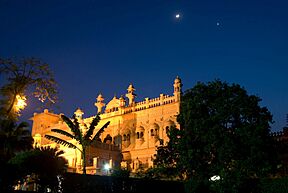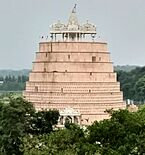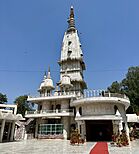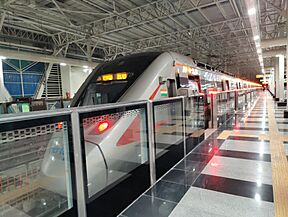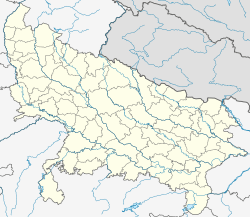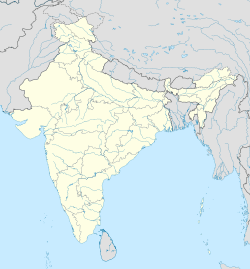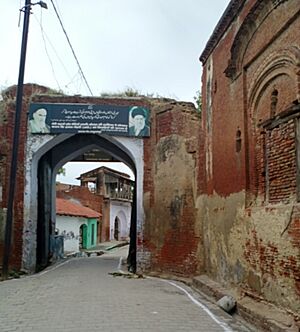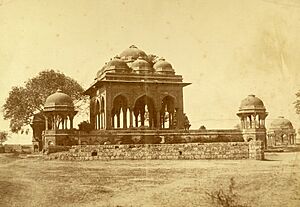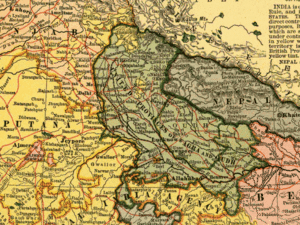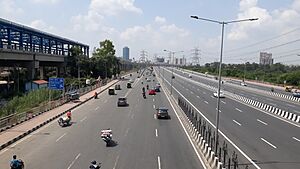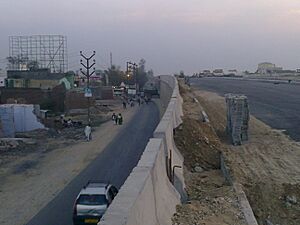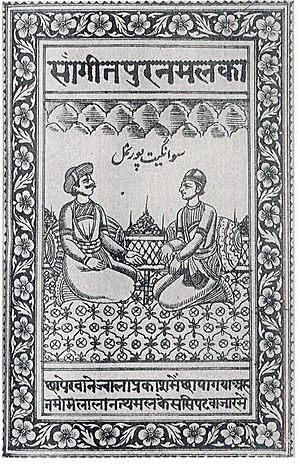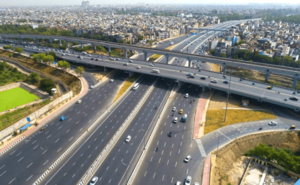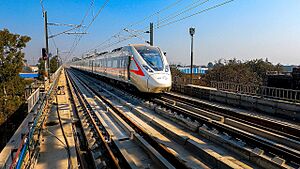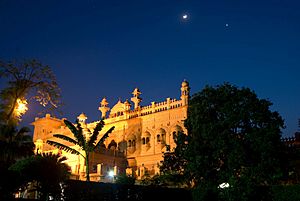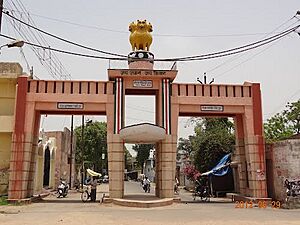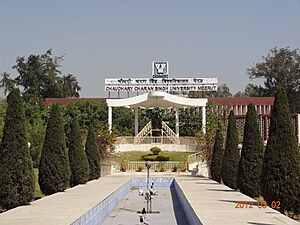Meerut facts for kids
Quick facts for kids
Meerut
Mēraṭha
|
|
|---|---|
|
Mustafa Castle
Ashtapad Hastinapur Jain Temple
Kali Paltan Mandir
Clock tower
Delhi Meerut Expressway
RRTS train
|
|
| Country | |
| State | Uttar Pradesh |
| Division | Meerut |
| District | Meerut |
| Government | |
| • Body | Meerut Municipal Corporation |
| Area | |
| • Metropolis | 450 km2 (170 sq mi) |
| Elevation | 247 m (810 ft) |
| Population
(2016)
|
|
| • Metropolis | 1,571,434 |
| • Density | 3,490/km2 (9,040/sq mi) |
| • Metro | 1,871,434 |
| Language | |
| • Official | Hindi |
| • Additional official | Urdu |
| • Regional | Khadiboli |
| Time zone | UTC+5:30 (IST) |
| PIN |
250 0xx
|
| Telephone code | 91- 121- XXXX XXX |
| Vehicle registration | UP-15 |
Meerut is a big city in the western part of Uttar Pradesh, a state in India. It's part of the National Capital Region (NCR). Meerut is the main city for the Meerut district.
It is about 80 kilometers (50 miles) northeast of New Delhi, India's capital. Meerut is the second-largest city in the NCR, right after Delhi. As of 2024, it is the 34th most populated city in India.
Meerut became important during the British Raj (British rule) in 1803. It was home to one of India's largest military camps, called a Cantonment. The Indian Rebellion of 1857 against British rule started here.
The city is sometimes called the 'Sports City of India'. This is because it makes a lot of sports equipment. Meerut is also known for making many musical instruments. It has one of Asia's largest gold markets too. Meerut is also a big center for education in western Uttar Pradesh.
India's first high-speed train system, the Delhi Meerut RRTS, is partly running in Meerut. The city is also connected by three major highways: the Delhi-Meerut Expressway, Ganga Expressway, and Meerut-Kanpur Expressway.
Contents
- What's in a Name?
- Meerut's Long History
- Meerut's Location and Weather
- How Meerut is Governed
- Meerut Cantonment: A Military Area
- Meerut's Economy and Growth
- Getting Around Meerut
- Meerut's Population
- Culture and Traditions
- Education in Meerut
- Media in Meerut
- Places to Visit in Meerut
- Famous People from Meerut
- See also
What's in a Name?
The name Meerut might come from Maya Rashtra. This was the capital of Mayasura, a mythical architect. He was the father of Mandodari, who was the wife of Ravana in ancient stories. Over time, the name changed to Mairashtra, Mai-dant-ka-khera, Mairaath, and finally Meerut.
Some stories say that King Yudhishthira gave land to Mayasura, and that's how the city started. Other ideas connect the name to Mahipala, a king of Indraprastha.
Meerut's Long History
Ancient Times
In the ancient story of the Ramayana, Meerut was called 'Maydant Ka Kheda'. It was the capital of May Danav and the hometown of Mandodari, Ravana's wife.
Scientists who dug up old sites near Meerut found signs that it might be where the ancient city of Hastinapur once stood. Hastinapur was the capital of the Kauravas and Pandavas from the Mahabharata story.
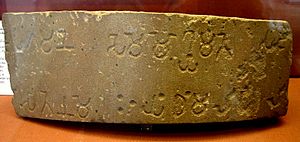
Meerut also had a settlement from the Harappan Civilisation, called Alamgirpur. This was the easternmost part of the Indus Valley civilisation. Meerut was a center for Buddhism during the time of Emperor Ashoka (273 BC to 232 BC). Remains of Buddhist buildings have been found near the Jama Masjid in the city. An Ashoka Pillar from Meerut was moved to Delhi by Firuz Shah Tughluq (1351–1388).
In Hindu stories, Meerut is linked to the Mahabharata. It is believed that Draupadi, a main character, was born here.
Later History
In the 11th century, a local ruler named Har Dat built a strong fort south-west of the city. He was defeated by Mahmud of Ghazni in 1018. The Jama Masjid in Meerut is said to have been built by Mahmud's chief minister around this time.
Later, Muhammad of Ghor's general, Qutb-ud-din Aybak, captured Meerut in 1193. In 1399, Timur attacked and destroyed Meerut. The city was rebuilt and later came under the Mughal Empire, enjoying a peaceful period. During Emperor Akbar's rule (1556–1605), Meerut had a mint that made copper coins.
From the 16th to the late 18th century, much of Meerut was controlled by the Sayyid Jagirdars of Abdullapur Meerut. The Kot Fort was built by Sayyed Mir Abdulla Naqvi Al Bukhari in the 16th century.
In the 18th century, the city faced attacks from Sikh and Maratha groups. Some parts of the area were ruled by Walter Reinhardt, a European soldier, and later by Begum Samru.
British Rule
In 1803, the British East India Company took control of Meerut. A large military camp, the Meerut Cantonment, was set up in 1806. This was because it was close to Delhi and in a fertile area. Meerut became the main city for its district in 1818.
Meerut is famous for the Indian Rebellion of 1857 against British rule. The famous slogan "Dilli Chalo" ("Let's march to Delhi!") was first said here. Meerut is also called "Kranti Dhara," meaning "the land of revolution," because India's independence movement began here.
The revolt started in March 1857 in Barrackpore. By April, it reached Meerut, which had a large British military presence. On April 24, 1857, 90 Indian soldiers of the Bengal Cavalry were ordered to use new rifle cartridges. These cartridges were rumored to be greased with animal fat, which was against the religious beliefs of both Hindu and Muslim soldiers. They refused to use them.
All 85 soldiers were punished and sent to prison for ten years. On May 10, 1857, Kotwal Dhan Singh Gurjar opened the prison gates. The soldiers escaped and started a rebellion, attacking British officials. This led to a widespread revolt across northern India, as the soldiers marched towards Delhi. May 10 is still a local holiday in Meerut.
Meerut was also where the Meerut Conspiracy Case happened in March 1929. Several trade union leaders were arrested by the British for organizing a railway strike. This case became well-known in England. Electricity first came to Meerut in 1931. The last meeting of the Indian National Congress before India's independence in 1947 was held in Meerut on November 26, 1946.
After Independence
After India gained independence, Meerut experienced some community conflicts. In 2006, a fire at a fair in Victoria Park Stadium caused many deaths.
Meerut's Location and Weather
Meerut is located between the Ganges and Yamuna rivers. The Meerut district covers about 2,522 square kilometers (974 sq mi), which is larger than Delhi.
Climate
Meerut has a humid subtropical climate. This means it has very hot summers and cooler winters. Summers are from early April to late June, with temperatures sometimes reaching 49°C (120°F).
The monsoon season starts in late June and lasts until mid-September. During this time, temperatures drop a bit, and there is more humidity and rain. From November to mid-March, Meerut has a mild, dry winter. The lowest temperature ever recorded was -0.4°C (31.3°F) on January 6, 2013.
Meerut gets about 845 millimeters (33 inches) of rain each year, mostly during the monsoon. This amount of rain is good for farming. The city was ranked 25th best "National Clean Air City" in India in 2024.
| Climate data for Meerut (1991–2020) | |||||||||||||
|---|---|---|---|---|---|---|---|---|---|---|---|---|---|
| Month | Jan | Feb | Mar | Apr | May | Jun | Jul | Aug | Sep | Oct | Nov | Dec | Year |
| Record high °C (°F) | 29.3 (84.7) |
32.2 (90.0) |
39.5 (103.1) |
43.8 (110.8) |
45.8 (114.4) |
46.1 (115.0) |
46.0 (114.8) |
40.0 (104.0) |
39.0 (102.2) |
38.0 (100.4) |
34.5 (94.1) |
30.0 (86.0) |
46.1 (115.0) |
| Mean daily maximum °C (°F) | 19.0 (66.2) |
22.9 (73.2) |
28.7 (83.7) |
36.0 (96.8) |
38.4 (101.1) |
36.6 (97.9) |
33.7 (92.7) |
33.1 (91.6) |
33.1 (91.6) |
32.2 (90.0) |
27.2 (81.0) |
22.0 (71.6) |
30.3 (86.5) |
| Mean daily minimum °C (°F) | 6.9 (44.4) |
9.9 (49.8) |
14.2 (57.6) |
19.2 (66.6) |
23.4 (74.1) |
25.4 (77.7) |
25.7 (78.3) |
25.1 (77.2) |
23.5 (74.3) |
17.5 (63.5) |
11.8 (53.2) |
7.8 (46.0) |
17.5 (63.5) |
| Record low °C (°F) | −0.4 (31.3) |
0.1 (32.2) |
5.4 (41.7) |
8.3 (46.9) |
15.4 (59.7) |
17.7 (63.9) |
16.5 (61.7) |
18.5 (65.3) |
15.7 (60.3) |
7.2 (45.0) |
1.8 (35.2) |
0.2 (32.4) |
−0.4 (31.3) |
| Average precipitation mm (inches) | 20.1 (0.79) |
32.2 (1.27) |
24.2 (0.95) |
15.7 (0.62) |
28.7 (1.13) |
81.9 (3.22) |
226.4 (8.91) |
217.9 (8.58) |
119.1 (4.69) |
16.4 (0.65) |
1.4 (0.06) |
4.9 (0.19) |
788.9 (31.06) |
| Average rainy days | 1.5 | 1.9 | 1.8 | 1.2 | 2.1 | 4.4 | 9.0 | 9.0 | 5.4 | 0.9 | 0.2 | 0.5 | 37.8 |
| Average relative humidity (%) | 64 | 55 | 48 | 34 | 35 | 51 | 71 | 73 | 69 | 59 | 58 | 62 | 56 |
| Source: India Meteorological Department (record high and low up to 2012) | |||||||||||||
How Meerut is Governed
City and District Management
The Meerut area is led by a Divisional Commissioner, who is a senior government officer. This person is in charge of local government and building projects in the area. The District Magistrate of Meerut reports to the Commissioner.
The Meerut district is managed by the District Magistrate (DM). The DM handles property records and collects taxes for the government. The district is divided into three smaller areas called tehsils: Meerut, Mawana, and Sardhana. Each tehsil has its own leader.
Police and City Services
The police in Meerut are part of the Uttar Pradesh Police. The Meerut police zone is led by a high-ranking police officer. The city's police force is headed by a Senior Superintendent of Police (SSP).
The Meerut Development Authority (MDA) plans and builds new things in the city. The Meerut Municipal Corporation manages the city's daily services, like keeping it clean. The Mayor is the official head of the corporation.
Meerut Cantonment: A Military Area
The Meerut Cantonment is a large military area set up by the British East India Company in 1803. It is one of the biggest cantonments in India by land size and population. The Indian Rebellion of 1857 started here, and Indian soldiers in this camp took part in the revolt. The cantonment surrounds the old city on three sides. It is well-connected by roads and railways.
Meerut's Economy and Growth
Meerut is one of the fastest-growing urban areas in the world. It is also the fastest-developing city in Uttar Pradesh, after Noida and Ghaziabad. A report in 2011 ranked Meerut as the 5th most "vibrant" city, even ahead of Delhi and Mumbai. This report looked at things like how many ATMs and bank branches there are, and how much people are buying.
Meerut is becoming a major center for transportation and goods. This is thanks to projects like the Eastern Dedicated Freight Corridor and new highways such as the Delhi–Meerut Expressway, Ganga Expressway, and Delhi Meerut RRTS.
Industries in Meerut
Meerut is an important industrial city in western Uttar Pradesh. It is known for its traditional handloom work and scissors industry. In the 19th century, Meerut was one of the first cities in northern India to have publishing companies.
Meerut is a good place for industries because it is a rich farming area and close to Delhi. As of 2011, it had 520 small and medium-sized businesses. Companies like Sanspareils Greenlands (SG) and Sareen Sports (SS), which are big sports goods makers in India, are based in Meerut.
Other industries in the city include tires, textiles, sugar, chemicals, and paper. Meerut is one of two main places in India where sports goods are made. Many famous cricket players have used bats made in Meerut.
Getting Around Meerut
Road Travel
Meerut has good road connections to big cities like Delhi, Noida, and Ghaziabad. Many people travel to these cities for work every day. Three national highways and two expressways pass through Meerut. The Delhi–Meerut Expressway, which is 90 km (56 mi) long, connects Meerut with Delhi. This expressway was opened in April 2021. The Ganga Expressway is also being built and will connect Meerut to Allahabad.
Meerut has two main bus stations. From here, buses travel to cities across the state and nearby areas. City buses, auto rickshaws, and rickshaws are common ways to get around inside the city.
Train Travel
Meerut is on the Delhi–Meerut–Saharanpur line. It has four railway stations: Meerut City, Meerut Cantt., Partapur, and Pabli Khas. Meerut City railway station is the busiest. The train line between Delhi and Meerut was built in 1864.
About 20,000 people travel between Meerut and Delhi by train every day. Trains also connect Meerut to cities like Mumbai, Ahmedabad, and Jaipur.
High-Speed Rail and Freight
The Delhi Meerut RRTS (RapidX) is a modern, high-speed train system. The first part of this system, from Sahibabad to Duhai, opened in 2023. The entire corridor is expected to be finished by March 2025. This system will also be used to move goods during non-peak hours.
The Eastern Dedicated Freight Corridor is a special railway line for cargo trains. It will run between Ludhiana and Dankuni, passing through Meerut.
Metro Project
The Meerut Metro project was approved in 2014 to improve public transport. It will have two main lines. The first line will go from Partapur to Pallavpuram, and the second from Rajban Market to Gokalpur village.
Air Travel
The closest airport is Hindon Airport in Ghaziabad, about 64 km (40 mi) away. The main international airport, Indira Gandhi International Airport in Delhi, is about 100 km (62 mi) away.
The Dr. Bhim Rao Ambedkar Airport is located in Partapur. There have been talks about making it an international airport to ease pressure on Delhi Airport. As of October 2023, the project is waiting for land approval from the Uttar Pradesh Government.
Meerut's Population
| Religions in Meerut City (2011) | ||||
|---|---|---|---|---|
| Religion | Percent | |||
| Hinduism | 61.15% | |||
| Islam | 36.05% | |||
| Jainism | 0.92% | |||
| Sikhism | 0.60% | |||
| Christian | 0.41% | |||
| Others† | 0.96% | |||
| Distribution of religions †Includes Buddhists (<0.09%). |
||||
In 2011, the Meerut Urban Agglomeration (Meerut UA) had about 1.42 million people. This is similar to the population of countries like Bahrain or Trinidad and Tobago. This makes Meerut the 33rd most populated urban area in India.
In Meerut, for every 1000 males, there are 897 females. About 13% of the population is under six years old. The overall literacy rate (people who can read and write) is 88.29%, which is higher than the state average. In Meerut Municipal Corporation, 83.78% of people spoke Hindi as their first language, and 15.25% spoke Urdu.
Culture and Traditions
Many traditional Indian festivals are celebrated in Meerut, including Holi, Dussehra, Diwali, and Eid. The Nauchandi Fair, which started in 1672, is held every year two weeks after Holi. This fair lasts for about 15 days and attracts many visitors. It includes poetry readings in Hindi, Urdu, and Punjabi.
Meerut is the center of the Roman Catholic Diocese of Meerut. The food in Meerut is a mix of Punjabi, Awadhi, and Mughlai styles. Many local dishes are vegetarian and sweet.
Nauchandi Fair
The Nauchandi Mela is a yearly fair held at Nauchandi Ground. It lasts for about a month and is organized by the Meerut Municipal Corporation. It usually begins on the second Sunday after Holi. The fair shows off the artistic and religious traditions of rural Uttar Pradesh. More than 50,000 people visit the fair each year. The Indian Railways' Nauchandi Express train is named after this fair.
The fair has a long history, going back hundreds of years. It started in 1672 as a one-day fair for trading cattle. It has been held every year since, except in 1858, the year after the Indian Rebellion of 1857 began in Meerut.
Today, the fair sells many different items. You can find Lucknow's Chikan embroidery, Moradabad's brassware, Varanasi's carpets and silk sarees, Agra's footwear, and Meerut's own products like sports goods, scissors, and sweets. Big rides, wheels, and circus acts are also popular attractions.
Film and Television
Meerut has its own film industry, popular in Western Uttar Pradesh and Haryana. These films are often based on folk stories, comedies, or local versions of Bollywood movies. Some movies filmed here include Sonu Ke Titu Ki Sweety, Zero, and Rajma Chawal.
Famous people from Meerut in the film and TV world include Bharat Bhushan, Aziz Mian, Mandakini, Achint Kaur, Kailash Kher, Chitrangada Singh, Vishal Bhardwaj, Deepti Bhatnagar, and Pravesh Rana.
Education in Meerut
Meerut is a big education center in Western Uttar Pradesh. It has several universities, many engineering and management colleges, and over 150 academic colleges and 50 schools. The city is home to Chaudhary Charan Singh University, Sardar Vallabhbhai Patel University of Agriculture and Technology, Swami Vivekanand Subharti University, Shobhit Institute of Engineering & Technology, and IIMT University.
There is one government engineering college, Sir Chhotu Ram Institute of Engineering and Technology. Schools in Meerut are linked to well-known education boards like ICSE, CBSE, and IB. St. Mary's Academy, Meerut is a top-ranked boys' school. St. John's Sr. Sec School, founded by Begum Samru, is over 130 years old.
IIMT Engineering College, now called IIMT University, is the oldest engineering institute in Meerut, started in 1997.
Chaudhary Charan Singh University (CCSU) is a public university with many colleges connected to it. Meerut also has three medical colleges: Lala Lajpat Rai Memorial Medical College, Subharti Medical College, and Mulayam Singh Yadav Medical College & Hospital.
Media in Meerut
Meerut is becoming a media hub. Many journalists from Uttar Pradesh and other states work here. Radio stations available in Meerut include Radio City 91.1 MHz, Big FM 92.7 MHz, and Red FM 93.5 MHz. Radio IIMT (90.4 MHz) is the only radio station located directly in the city.
Hindi daily newspapers like Hindustan (newspaper), Dainik Jagran, and Amar Ujala are published from Meerut. The English daily Times of India also has a Meerut edition.
Places to Visit in Meerut
Here are some interesting places to visit in and around Meerut:
- Digamber Jain Bada Mandir Hastinapur – This place is considered very holy by Jains. It is believed to be the birthplace of three Jain Tirthankaras (spiritual teachers). There are many old Jain temples here, along with the Pandeshwar temple, a historical Gurdwara, and the Hastinapur Sanctuary.
- Government Freedom Struggle Museum and Shaheed Smarak – The Government Freedom Struggle Museum in Meerut opened in 1997. It is located in the Shaheed Smarak (Martyr's Memorial) area. The museum collects and displays items related to India's freedom struggle, especially the events of 1857. It also organizes educational programs about history and culture.
- Shahi Jama Masjid – This mosque was built in 1019 AD. It is considered one of the oldest mosques in North India.
- St. John's Church – This church was built by the East India Company between 1819 and 1822. It is one of the oldest churches in North India and can seat 10,000 people. It was a site of fighting during the 1857 War.
- Augarnath Temple – This temple is also known as Kalipaltan Mandir. It is where soldiers planned their actions during the 1857 War. The temple also has a memorial for the brave people who died in the rebellion. It is also believed to be a very old Shiva temple.
Other interesting places include Mansa Devi Temple, Baleni, Basilica of Our Lady of Graces, Sardhana, and the Chandi Devi Temple.
Famous People from Meerut
From the 1857 Rebellion
- Dhan Singh Gurjar
- Kadam Singh, a leader who fought against the British during the 1857 Rebellion.
In Films and Music
- Deepti Bhatnagar
- Bharat Bhushan
- Arun Govil
- Achint Kaur
- Kailash Kher
- Chitrangada Singh
- Sanjeev Tyagi
In Politics
- Rajendra Agrawal, a Member of Parliament for Meerut.
- Dr. Laxmikant Bajpai, a former political leader.
- Malook Nagar, a businessman and politician.
- Pyare Lal Sharma, a freedom fighter and the first Education Minister of Uttar Pradesh.
- Somendra Tomar, a Member of the Legislative Assembly for Meerut South.
In Sports
- Mohd Asab, a shooter.
- Manu Attri, a badminton player.
- Saurabh Chaudhary, a shooter.
- Garima Chaudhary, a judoka.
- Romeo James, a field hockey player.
- Bhuvneshwar Kumar, a cricketer.
- Praveen Kumar, a cricketer.
- Raman Lamba, a cricketer.
- Shivam Mavi, a cricketer.
- Annu Rani, an athlete.
- Sameer Rizvi, a cricketer.
- Shahzar Rizvi, a shooter.
- Karn Sharma, a cricketer.
- Shardul Vihan, a sport shooter.
Scholars and Thinkers
- Sir Ziauddin Ahmed, an academic and politician.
- Satish Chandra, an Indian historian.
- Anu Garg, an educationist and author.
- Manu Prakash, a scientist.
See also
 In Spanish: Meerut para niños
In Spanish: Meerut para niños
- Meerut Lok Sabha constituency
- Largest Indian cities by GDP


